Apple variety Champion
The Champion apple tree is one of the most popular varieties in Europe. It was taken out in the Czech Republic in 1970. Now the main producer of these apples is Poland.
- Variety characteristic
- Description of the tree and fruit
- Taste
- Yield
- Pollinators
- Winter hardiness
- Disease resistance
- Growing regions
- Landing
- Timing
- Site preparation
- Sapling selection
- Landing technology
- Care
- Watering
- Top dressing
- Pruning and shaping the crown
- Pests, diseases and control of them
- Features of ripening and fruiting
- Harvesting and storage
- Subspecies
- Rootstock options
- Gardeners reviews
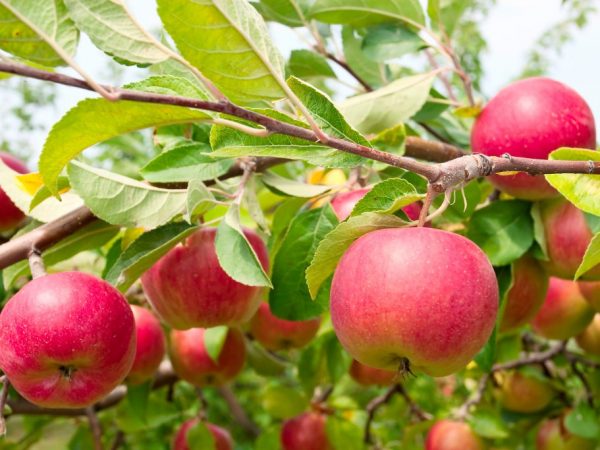
Apple variety Champion
Variety characteristic
The champion received after crossing Golden Delicious and Reneth Orange Cox (Orange Reneth).
He adopted the best qualities of his parents. Compact trees are well suited for growing in limited areas. Large fruits have not only good taste, but also an excellent presentation.
Description of the tree and fruit
A feature of the variety is considered to be a slow annual growth. Before the beginning of fruiting, it is 40-50 cm, then it drops significantly.
The buds of the tree are quickly stimulated after the first warm days. Therefore, there is a risk that they will be damaged by late frosts.
Description of the Champion apple tree:
- The height of the tree is 4-5 m, the mass of apples is 160-200 g
- Inflorescences consist of 4-5 buds
- Fruit color with barely visible blush-like stripes
Taste
The Champion apple has a sweet and sour taste. The pulp has a rich aroma, full of juice. Tasters appreciate this variety.
Yield
15-25 kg of fruit can be harvested from one tree. Considering that it is very small, with a compact crown, then such results are very high.
In 7-12 years, up to 5 tons of products can be harvested from 1 hectare.
Pollinators
According to the description, the Champion apple variety is partially self-fertile. The pollen viability is 32-60%. With self-pollination, 18-32% of the flowers turn into ovaries. But if pollinators grow nearby, the yield increases significantly.
The best varieties are:
- Teremok
- James Grieve
- Idared
- Spartan
- Pilot
- Lobo
- Gala
- Florina
- Piros
- Alcmene
- Pinova
- Priam
There should be 1 pollinator for 10-12 trees.
Winter hardiness
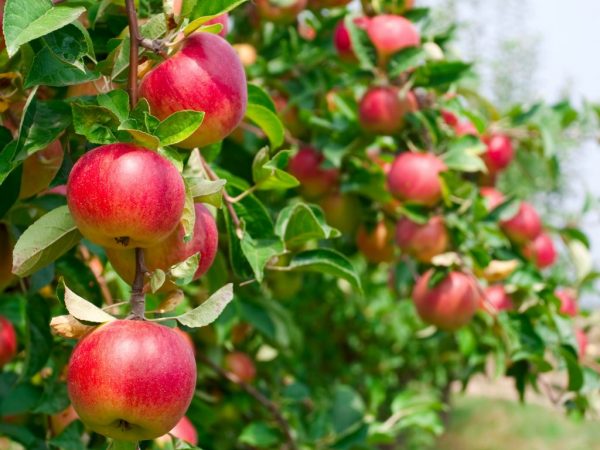
The tree tolerates frost well
The Champion variety has an average winter hardiness: an apple tree can withstand frosts down to - 18-20⁰. In his homeland, Central Europe, temperatures rarely drop below these levels in winter.
In the Moscow region, in the Urals and the northern regions of Russia, it is recommended to cover the tree for the winter. You can limit yourself to insulating the trunk, but in harsh winters, it is better to protect the branches. It is important to keep track of when the buds open. If they are already swollen, and frost is predicted, it is better to cover the apple tree for the night.
Disease resistance
When creating a variety, breeders did not pay special attention to such characteristics as resistance to fungi and bacteria.
The tree resists scab well, but powdery mildew affects it. Champion susceptible to fire blight. One of the most common problems is the bitter pitting of fruits associated with a lack of calcium.
Growing regions
Poland is the leader in the cultivation of the Champion. Most of the apples are exported from this country.They also love the variety at home, in the Czech Republic and Slovakia. Back in the 80s, the species was brought to Ukraine, where it successfully took root. It is cultivated in Belarus and the Baltic countries.
In Russia, the Champion has become popular among gardeners in the Moscow region. Here it can be cultivated without much winter protection. It is enough to insulate the trunk. Apple trees are also grown in the South Urals. They have taken root well in the regions bordering on Belarus and Ukraine, and in some southern regions.
Landing
It depends on the correct planting of the apple tree how much it will take root, whether it will give a normal harvest and when it begins to bear fruit. It also affects resistance to certain diseases.
Timing
In the conditions of the Moscow region and the South Urals, it is better to plant an apple tree in the spring. This variety is sensitive to frost. A young, fragile seedling may die in winter. The optimal time for spring planting is the end of April or the first days of May. By this time, the ground warms up well, and the risk of late frosts decreases.
If the seedlings are purchased in the fall, they can be dug in for the winter. Choose a site that is closed from the winds. They dig a groove with a depth of 30-50 cm, insert seedlings there at an angle of 45⁰. The tops of the twigs are directed to the south. You can cover them on top so that the kidneys do not freeze in winter.
In warm areas, apple trees can be planted in the fall. It is best to do this in mid-October, a few weeks before the winter cold snap. For safety net, the seedlings are covered with foil.
Site preparation
A sunny spot protected from northern winds is considered optimal. It is important to note that this variety is afraid of flooding by groundwater. Their level can be no higher than 2.5 m from the top layer of the soil. Also, acidic and too alkaline soils (with a high content of carbonates) are not suitable for the tree. But the tree grows well on loam and sandy loam.
The place begins to be prepared in the spring, a year or 6 months before planting. Thoroughly dig up the ground, remove weeds, stones.
After that, you can sow the area with siderite plants, which enrich the soil with nitrogen. Clover, vetch, lupine, peas, mustard, rye, buckwheat are suitable. When the plants turn green (but even before the seeds appear), they are mowed and dropped on the site.
Pit preparation
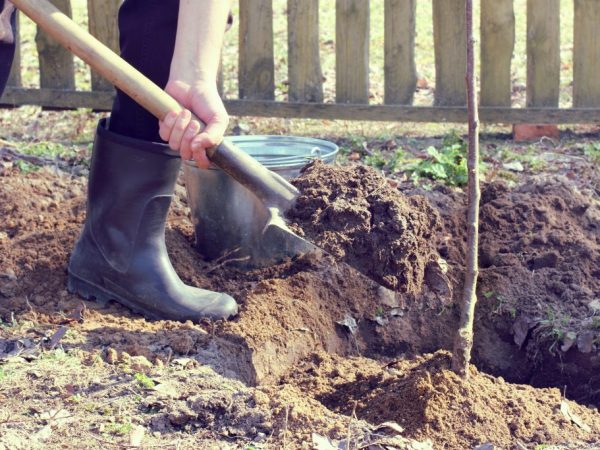
The landing pit is prepared in advance
Both in autumn and in spring planting, the pit is prepared in September. On black soil or sandy soil, its depth and width should be 60-80 cm (40 cm is enough for dwarfs). They dig a hole in the clay 80 cm deep and 1 m wide in order to arrange drainage.
The earth from the bottom is taken out to the garden, and the upper fertile layer is mixed with fertilizers of the following composition:
- Rotted manure - 30 kg
- Superphosphate - 1 kg
- Potassium chloride - 100 g
- Wood ash - 800 g
- Lime - 300 g
A peg is driven into the bottom of the pit and covered with the resulting mixture. If the soil is clay, drainage from coarse sand, expanded clay, crushed brick, fine gravel or pebbles is laid from below. Around the pit they dig a small groove to drain water and fill it with sand. At the end, everything is poured with a bucket of water to compact the earth.
Sapling selection
Two-year-old seedlings are best suited for planting. Unlike one-year-olds, they have 3-5 lateral branches. The stem must be even, without damage. The bark is gray-brown, through which a greenish bast is visible.
Be sure to inspect the root system. The seedling should have 3-4 main roots, several thin shoots depart from them. To test the elasticity, screw the spine onto your finger. If it is easy to do it, then his vital activity is normal. The root collar should be of normal thickness, clean, and free from defects. When transporting the roots, cover with a rag or hide in a special package.
Landing technology
The gap between standard trees in a row is 3.5 m, and between rows - 5 m.For dwarfs and semi-dwarfs, a distance of 2-2.5 m is enough, and between rows - 3.5-4.5 m.If the seedlings were stored for a long time, they are put in water for a day to revive the roots.
Landing technique:
- Part of the earth is removed from the pit
- They form a small mound from the remains
- They put a tree on a mound and spread the roots around it
- They begin to gradually fill the hole, periodically shaking the seedling (this allows the soil to be evenly distributed around the roots)
- Compaction of the earth (stronger on the periphery, weaker - at the trunk)
- Tie the seedling to the support
- Poured in a circle, at a distance of 20-30 cm from the trunk, 2 buckets of water
- Line mulch around the trunk
When backfilling, it is necessary to monitor the root collar. It should rise 5-7 cm above the ground.
Care
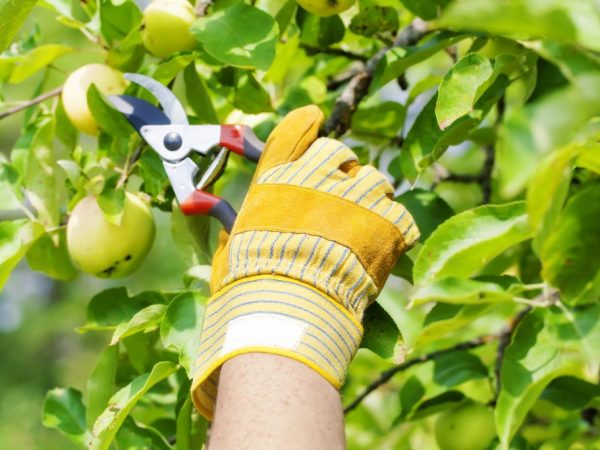
The tree needs good care
Good care increases the lifespan of trees, the duration of fruiting, and ensures annual yields.
Watering
According to the description of the variety, Champion tolerates drought well, but the apple tree is sensitive to excess moisture.
Young seedlings should be watered once a week. Mature - 4-5 times a season. In the first year of life, 30 liters of water are poured under one tree at a time, then this amount is increased by a bucket for each year of life. By the age of 6-7 years, the volume of fluid should be about 100 liters.
For irrigation, special grooves are equipped with a depth of about 15 cm. The first is dug in a circle at a distance of 1 m from the trunk, the second - 50 cm further from the first. Single apple trees are watered in holes near the trunk. After moistening, the soil is loosened and covered with mulch.
For mature trees, additional water is needed before and after flowering, during ovary formation and fruit loading.
If the groundwater is deep, the tree is watered in November. This helps to compact the soil and protects the roots from freezing. When the groundwater is high, the tree is not watered in late autumn.
Top dressing
The apple tree responds well to fertilizers, increases its yield. The alternations of organics and minerals are especially useful for her. Both root and foliar dressings are used. They begin to be introduced from 2-3 years after planting.
As an organic fertilizer, a solution of manure 1:10 or chicken manure 1: 20 is used. To it add 1 tbsp of nitroammophoska and the same amount of ammonium nitrate. The solution is poured into a ditch (from 2 to 4.5 m).
Young trees need 15-25 liters of fertilizer, 10-year-olds need 50-60 liters, and at 12 years old - 80 liters.
When the fruits are tied, the apple tree is fed with potassium chloride (50 g) and superphosphate. Before wintering, add a superphosphate solution (50 g / l of water).
As foliar dressings are used:
- Bordeaux liquid with urea (5 g / l) or ammonium nitrate (3 g / l). Spray trees immediately after flowering.
- Potassium sulfate (20 g / 10 L) and superphosphate (40 g / 10 L). This mixture is used at the end of summer, when the fruits begin to ripen.
You need to spray trees in the early morning or late evening, in dry and calm weather.
Pruning and shaping the crown
Pruning begins the next year after the spring planting and the first after the fall. Before the first fruits appear, a crown must be formed. Then carry out cleaning and corrective trimming. All manipulations are carried out before the intensive circulation of juices begins.
At the first formative pruning, remove all twigs that are lower than 50 cm from the ground. 3 strong branches are left on the tree (they are cut off by a third) and a central conductor. The length of the main branch in the center should be 15-20 cm from the point of divergence of the lateral shoots.
In the course of the next years, the second and third tiers are formed. 2-3 branches are left on them, cutting them off by a third. The intervals between the tiers are about 50 cm. Weak shoots are removed completely. The central twig is cut off at the top when the apple tree reaches the desired height.
In subsequent years, when correcting the crown, all annual shoots that do not end with a generative bud are cut off, grow parallel to the trunk, have a length of less than 25 cm. Branches older than 3 years are also cut off, leaving replacement knots. Be sure to inspect the tree for the presence of diseased and damaged processes, they are also removed completely.
Pests, diseases and control of them
The Champion apple tree is susceptible to many diseases.
Bacterial burn

The apple tree is susceptible to many diseases
The pathology is caused by bacteria. First, orange specks appear in the center of the leaves, resembling burns. Then they "spread" over the entire plate. In parallel, flowers and young apples are affected. At the end, bacteria infect the bark, spots and cracks appear on the branches and trunk.
To combat bacterial burns, antibiotics are used - ampicillin or gentamicin. The ampoule is diluted in a liter of water and the tree is pollinated. Pathology is difficult to treat. Very often apple trees have to be uprooted. The second time in this place it is not recommended to plant it.
Bitter pitting
Pathology is associated with a lack of calcium, characteristic of large-fruited varieties. Small specks appear on the apple (up to 3 mm in diameter), greenish or dark red. Then they increase, the pulp becomes loose in structure and bitter in taste. It is impossible to eat such fruits.
To prevent disease, the tree is treated with 0.4% -0.6% calcium chloride solution in the second half of July. Ripe apples can be dipped in a 4% solution of the same substance. It is important to monitor the reaction of the soil. If it is too acidic, liming is carried out.
Fungal diseases
Fungi can destroy not only the harvest, but also the apple tree itself. Powdery mildew appears as a white bloom on the leaves, rust as red spots. This slows down photosynthesis and disrupts plant nutrition. For control and prevention, fungicides are used:
- Copper sulfate (50-100 g / 10 l) - during the period of kidney development
- Chorus (2 g / 10 L) - during bud formation
- Speed (2 ml / 10 l) - when pouring fruits
Also effective are the drugs Delan, Poliram, Topsin, Atrakor.
Pests
The Champion is most often attacked by the apple moth, aphid, apple sawfly, and spider mites. The best insecticide pests are insecticides. They use drugs Hom, Karbofos, On the spot, Kemifos, Lepidotsid, Calypso, Decis, copper sulfate.
With a slight lesion, you can use folk remedies - infusion of garlic, onions, dill, soapy water. Wormwood, tansy, marigolds planted in the garden scare away insects.
Features of ripening and fruiting
The Champion variety is distinguished by an early onset of fruiting. Already for 3-4 years, you can harvest the first crop. 6-7 years after planting, the apple tree yields 15 kg of fruits, and after 10 years - 20-30 kg.
The varieties on the dwarf rootstock bear fruit even earlier. If they are planted in the fall, then the next year they already begin to bloom profusely and form ovaries. Flowers are recommended to be cut for up to three years so as not to deplete the tree. If this is not done, the plant may die.
The spring flowering of adult apple trees is abundant, but some of the flowers and ovaries fall off. Therefore, you do not need to thin out the flowers.
On older trees, in especially fruitful years, you can regulate fruiting so that they do not deplete and the apples are larger. Ovaries are formed on ringlets, fruit twigs and spears.
Fruits begin to ripen at the end of August, and reach their final ripeness at the end of the first decade of September. First, the peel turns yellow, then it becomes covered with red stripes, which merge into a solid blush. The more light the fruit receives, the more intense its color.
On young trees, the fruits hold on tightly, from old trees they can fall off. Sometimes in 1-2 days you can lose the entire crop, so they are recommended to be harvested during the period of technical maturity.
Harvesting and storage
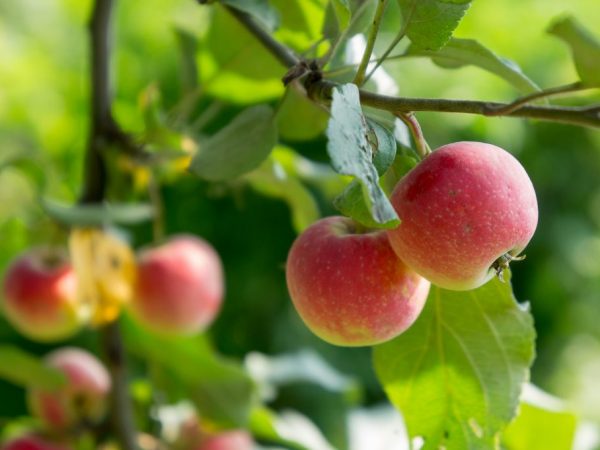
It is recommended to harvest ripe fruits.
The collection of Champion apples starts from early to mid-September, depending on the region. They should be mature enough, but still firm.
The fruits are easily removed from the branches. They are put in boxes so that they do not touch each other. It is best to use special cardboard or plastic containers with cells. But apples can be separated with sawdust, dry grass, straw, or wrapped in thin paper.
In the basement or at home, fruits are stored for 1.5-2 months, in the refrigerator - up to six months.It reaches its optimal taste characteristics 2 weeks after harvest - it becomes sweeter and more tender.
If grown on an industrial scale, it is worth purchasing a special refrigerator for storage. Conditions in it:
- Temperature - from 1⁰С to 1.5⁰С
- Oxygen content - 1.5-2%
- Carbon dioxide content - 1.5-4%
The camera must be equipped with ventilation. For better preservation, the fruits are treated with ozone. If there is no opportunity to purchase a camera, it is better to sell the products immediately. Many people dry these apples, make jams and preserves from them, and crush juices.
Subspecies
Today there are several subspecies.
- Renault Champion. The subspecies got its name from the first syllables of the surnames of its creators - Reitman and Novakovsky. Differs in the best frost resistance, is able to withstand temperatures up to - 30⁰С. Well suited for growing in northern regions. The pulp contains more sugar, which is why it is sweeter. The tree is shorter and the fruit is more intense red.
- Champion Arno. Apple trees are tall, with a dense crown. The fruits are bright, orange-red, with pronounced stripes and lenticels. The pulp is of medium density, softer and sweeter than that of the main variety.
- Champion Giant. He has huge oval fruits that can weigh about a kilogram. The rest is not much different from the parent. Frost resistance is low, therefore the subspecies is suitable only for cultivation in the southern regions.
Rootstock options
- Dwarf. Height up to 2.5-3 m, crown of medium density. Fruits weighing 160-200 g, the yield is abundant, begins to bear fruit already in the 2nd year after planting. A low apple tree is easier to care for, it is easier to remove fruits from it.
- Semi-dwarf. Height - 3-5 m, standard fruits, very juicy and sweet.
- Columnar. The height of the tree is about 2.5 m. The crown is narrow, up to 30-50 cm wide. The branches grow almost parallel to the trunk. Apples are slightly smaller, 140-190 g, sweet and juicy. 12-15 kg of products are harvested from one tree. The disadvantage of the subspecies is a short fruiting period - up to 10-12 years.
The choice of a subspecies depends on the preferences of the gardener and the goals of growing. For example, in the north, Renault is more often chosen. For fans of records, Giant will suit.
Champion apples can be sent to exhibitions. For industrial cultivation, dwarf and columnar varieties are often chosen. They take up little space on the site, they quickly begin to bear fruit.
Gardeners reviews
The Champion apple variety is becoming more and more popular in Russia. They celebrate the excellent taste and beauty of the fruit. Large red apples on the branches become a real decoration of the garden. They have a good presentation, so they are easy to sell.
Apple trees are not very tall. If you buy seedlings on a dwarf or semi-dwarf rootstock, they will take up very little space. In addition, these varieties bear fruit very early. Already in the 3rd year, the first crop can be harvested. And after another 5-6 years, the apple tree reaches its maximum productivity. The standard type can bear fruit for up to 50 years.
The calorie content of apples is low, so they are quite suitable for a diet.
There are also negative reviews about the variety. Some people complain that young seedlings often freeze out. To protect them, they have to be closed for the winter, and this is an extra waste of time and money. They also note sensitivity to diseases that can even lead to the death of the tree. There is a problem of fruit falling off old apple trees. This happens very quickly, in 1-2 days.

